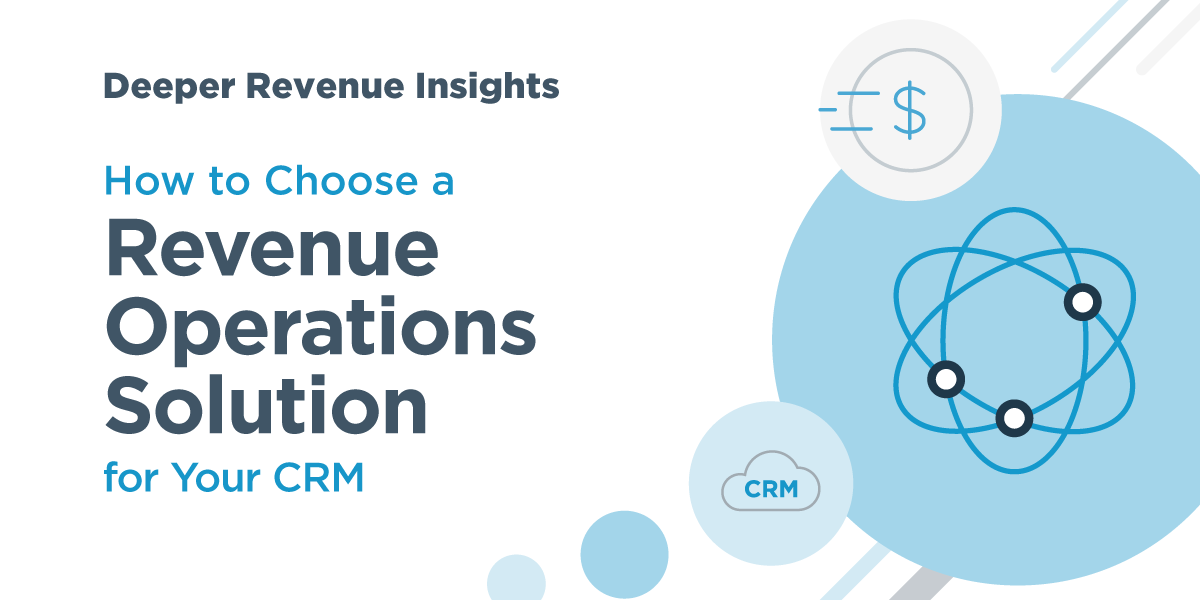Revenue analytics, BI reports, and spreadsheets were built for operations, NOT for revenue teams. These disconnected and disjointed reports require customization, analysis and a heavy lift from operations. Plus, by the time they get to your revenue leaders, managers, and reps, they’re old news because the data they rely on is not real-time.
The process of reporting and analyzing sales data is broken, but a revenue operations solution could be exactly what you need to modernize your revenue process.
In part 1 of our RevOps buyer’s guide series, we specified the 4 critical components that every revenue operations solution should have:
- Trustworthy data and automation;
- Deeper revenue insights;
- Consistent execution;
- Predictable revenue.
We started with trustworthy deal data that is automated and pulled in from all of your business systems because it can be so transformational for your CRM hygiene.
But here’s the caveat:
If you’re wasting a lot of time digging through data or pulling custom-built reports from CRM, it could end in a horrible user experience with poor visibility into your revenue risk and opportunity. The truth is, even with exceptional data hygiene, your business intelligence tools or spreadsheet reporting is not giving you the deep revenue insights you need to drive more revenue.
Those reports are failing you for a number of reasons:
- Reports aren’t pulled by the people who use them: The entire go-to-market team needs access to personalized insights about the pipeline, deals, and forecast. Often operations are the only department that has access to this data, which results in a lot of back and forth and wrong conclusions.
- Reports aren't flexible: Since your reps and managers aren’t able to pull their own reports, they're not able to hone in on the details that matter most to them.
- Reports aren’t real-time: A report, by nature, must be pulled and reviewed, sometimes sitting in your inbox for days. Meanwhile, your deal is developing in real-time, meaning your report could be out-of-date and inaccurate.
- Reports aren’t actionable: Reports do not come with predictive and prescriptive insights. Your time is instead spent finding patterns and guessing where to focus your time.
In part 2 of our RevOps buying guide blog series, we will walk you through why deeper revenue insights matter — and how to find a Revenue Operations solution to get you there.
Revenue Operations Solutions to the Rescue
First things first: a little background on the importance of a Revenue Operations solution. A Revenue Operations solution gives you real-time visibility into your deals, as well as broad accessibility so anyone at the company can see the engagement and activity levels of all deals. Revenue Operations solutions use AI to analyze historical deal trends and patterns so you know which deals are at risk, where to focus, and ultimately where you will land for this quarter and next. You no longer need to wait around for someone else to build a report — it’s all right there in one place.
Adding an AI-based Revenue Operations Solution to your CRM is the way modern sales teams improve their data hygiene, save time, and replace the hodgepodge of untrustworthy spreadsheets and stale reports. With one unified system and working within a solid revenue operations framework, revenue teams can align around the same numbers and predict revenue more effectively.
Why Are Deeper Revenue Insights Important in a RevOps Solution?
Deep revenue insights will improve the way you view and inspect deals across your go-to-market teams, helping you uncover risk faster and win more deals. Real-time analytics provided by Revenue Operations solutions give the entire revenue team, from rep to CMO, visibility into deals and pipeline.
In addition, AI-driven insights can make your analytics more actionable, directing you to where you have upside opportunities, pipeline coverage gaps, deals at risk of slippage, accounts at risk of churning, and upsell potential, ultimately providing more revenue predictability.
Your insights should be your single source of truth to reduce interrogations and create transparency and accountability across sales, marketing, and customer success. The ability to analyze deal trends and risk in one place lets your entire GTM team quickly identify deals that need more attention, removing guesswork and saving time.
In short, deeper revenue insights are critical to driving better, more predictable results across your GTM team.
How Can You Evaluate a RevOps Solution for Deeper Revenue Insights?
So what exactly should you be looking for in a Revenue Operations solution?
- Verify that insights and analytical views are easily available and do not require a massive development effort to configure and build-out.
- Look for how reps, managers, sales leaders, marketers, and other stakeholders can use the data in their daily workflows to ensure you have high adoption across your revenue organization.
Key Revenue Insight Features to Look for a RevOps Solution
We’ve compiled a list of critical capabilities every Revenue Operations solution should include.
- AI opportunity scoring: the ability to provide an opportunity score based on behavioral patterns so you can see deal risk and know where to focus.
- AI opportunity score tuning: the ability to tune the scoring algorithm based on certain characteristics, such as rep activity and seasonality.
- Activity scoring: the ability to score opportunities based on the level of sales activity, so that high or low engagement levels are easier to spot.
- Opportunity insights: the ability to view all activities associated with opportunities so sales and marketing can know when to re-engage inactive deals.
- Opportunity risk assessment: the ability to inspect deal risk based on CRM activity as well as rep email and calendar activity.
- Pipeline progress inspection: the ability to see how the pipeline is evolving throughout the quarter so marketing and sales can know where more pipeline build is needed.
- Tracking global, historical pipeline changes between any two points in time: the ability to view pipeline changes by forecast category or stage, including the ability to see deals that slipped, closed-won/lost, changed forecast categories or were added to the quarter.
- Real-time update indicators: the ability to show historical changes to opportunity fields in real-time and highlight deals with no recent updates.
- Suggested pipeline coverage for future quarters: the ability to generate a pipeline coverage suggestion for future quarters.
- Quarter-over-quarter status: the ability to compare the status of the current quarter with the same time in previous quarters so teams can see how the business is trending over time.
- Rep activity insights: the ability to view activity at the rep level and rank reps by activity metrics, allowing managers to determine which reps need more coaching.
- Account engagement insights: the ability to see customer engagements across all accounts so you can re-engage them at the account level.
Modernizing your revenue process shouldn’t be hard. With a Revenue Operations Solution, you can drastically transform the way you drive revenue growth and retention for your business.
To uncover more must-have capabilities to select the right AI-based RevOps solution for your business download our ebook "How to Choose a Revenue Operations Solution for Your CRM" and supercharge your revenue process today.



